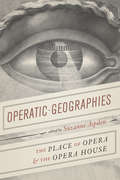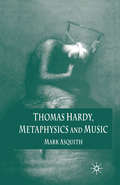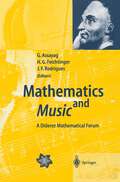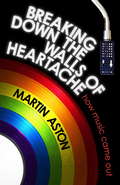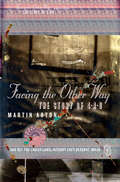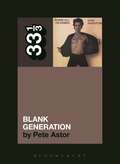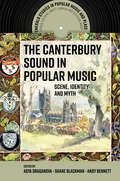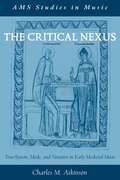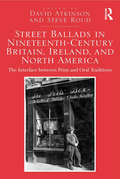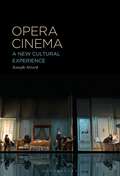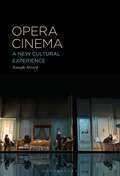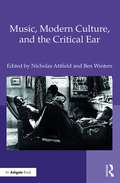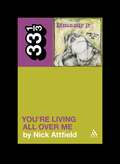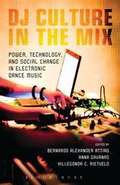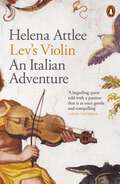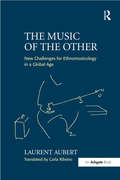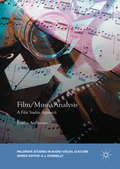- Table View
- List View
Operatic Geographies: The Place of Opera and the Opera House
by Suzanne AspdenSince its origin, opera has been identified with the performance and negotiation of power. Once theaters specifically for opera were established, that connection was expressed in the design and situation of the buildings themselves, as much as through the content of operatic works. Yet the importance of the opera house’s physical situation, and the ways in which opera and the opera house have shaped each other, have seldom been treated as topics worthy of examination. Operatic Geographies invites us to reconsider the opera house’s spatial production. Looking at opera through the lens of cultural geography, this anthology rethinks the opera house’s landscape, not as a static backdrop, but as an expression of territoriality. The essays in this anthology consider moments across the history of the genre, and across a range of geographical contexts—from the urban to the suburban to the rural, and from the “Old” world to the “New.” One of the book’s most novel approaches is to consider interactions between opera and its environments—that is, both in the domain of the traditional opera house and in less visible, more peripheral spaces, from girls’ schools in late seventeenth-century England, to the temporary arrangements of touring operatic troupes in nineteenth-century Calcutta, to rural, open-air theaters in early twentieth-century France. The essays throughout Operatic Geographies powerfully illustrate how opera’s spatial production informs the historical development of its social, cultural, and political functions.
Operatic Geographies: The Place of Opera and the Opera House
by Suzanne AspdenSince its origin, opera has been identified with the performance and negotiation of power. Once theaters specifically for opera were established, that connection was expressed in the design and situation of the buildings themselves, as much as through the content of operatic works. Yet the importance of the opera house’s physical situation, and the ways in which opera and the opera house have shaped each other, have seldom been treated as topics worthy of examination. Operatic Geographies invites us to reconsider the opera house’s spatial production. Looking at opera through the lens of cultural geography, this anthology rethinks the opera house’s landscape, not as a static backdrop, but as an expression of territoriality. The essays in this anthology consider moments across the history of the genre, and across a range of geographical contexts—from the urban to the suburban to the rural, and from the “Old” world to the “New.” One of the book’s most novel approaches is to consider interactions between opera and its environments—that is, both in the domain of the traditional opera house and in less visible, more peripheral spaces, from girls’ schools in late seventeenth-century England, to the temporary arrangements of touring operatic troupes in nineteenth-century Calcutta, to rural, open-air theaters in early twentieth-century France. The essays throughout Operatic Geographies powerfully illustrate how opera’s spatial production informs the historical development of its social, cultural, and political functions.
Operatic Geographies: The Place of Opera and the Opera House
by Suzanne AspdenSince its origin, opera has been identified with the performance and negotiation of power. Once theaters specifically for opera were established, that connection was expressed in the design and situation of the buildings themselves, as much as through the content of operatic works. Yet the importance of the opera house’s physical situation, and the ways in which opera and the opera house have shaped each other, have seldom been treated as topics worthy of examination. Operatic Geographies invites us to reconsider the opera house’s spatial production. Looking at opera through the lens of cultural geography, this anthology rethinks the opera house’s landscape, not as a static backdrop, but as an expression of territoriality. The essays in this anthology consider moments across the history of the genre, and across a range of geographical contexts—from the urban to the suburban to the rural, and from the “Old” world to the “New.” One of the book’s most novel approaches is to consider interactions between opera and its environments—that is, both in the domain of the traditional opera house and in less visible, more peripheral spaces, from girls’ schools in late seventeenth-century England, to the temporary arrangements of touring operatic troupes in nineteenth-century Calcutta, to rural, open-air theaters in early twentieth-century France. The essays throughout Operatic Geographies powerfully illustrate how opera’s spatial production informs the historical development of its social, cultural, and political functions.
Thomas Hardy, Metaphysics and Music
by Mark AsquithThis fascinating new study by Mark Asquith offers an original approach to Hardy's art as a novelist and entirely new readings of certain musical scenes in Hardy's works. Asquith utilizes a rich seam of original archival research (both scientific and musicological), which will be of use to all Hardy scholars, and discusses a range of Hardy's major works in relation to musical metaphors - from early fiction The Poor Man and the Lady to later major works Jude the Obscure, Far From the Madding Crowd, the Mayor of Casterbridge .
Mathematics and Music: A Diderot Mathematical Forum
by Gerard Assayag Hans G. FeichtingerIn Western Civilization Mathematics and Music have a long and interesting history in common, with several interactions, traditionally associated with the name of Pythagoras but also with a significant number of other mathematicians, like Leibniz, for instance. Mathematical models can be found for almost all levels of musical activities from composition to sound production by traditional instruments or by digital means. Modern music theory has been incorporating more and more mathematical content during the last decades. This book offers a journey into recent work relating music and mathematics. It contains a large variety of articles, covering the historical aspects, the influence of logic and mathematical thought in composition, perception and understanding of music and the computational aspects of musical sound processing. The authors illustrate the rich and deep interactions that exist between Mathematics and Music.
Breaking Down the Walls of Heartache: A History of How Music Came Out
by Martin AstonPopular music's gay DNA is inarguable, from Elvis in eye shadow and Little Richard's 'Tutti Frutti' to The Velvet Underground's subversive rock'n'roll and Bowie's ambisexual alien Ziggy Stardust; from kd lang's female Elvis to Kurt Cobain in a dress; from Noughties lesbian icon Beth Ditto to Lady Gaga's 'Born This Way' manifesto. But if collected essays and/or features have addressed gay, lesbian, bisexual and transgender singers, songwriters, musicians and songs, no book has yet comprehensively and authoritatively drawn together all the threads to explore this as an unfolding, historical narrative: to tell the story of how music 'came out', from the days when homosexuals were deeply in the closet, but the love that once dared not speak its name sings it, and on daytime radio to boot.This story will reveal which songs have coded messages about sexuality, and which proudly declared the truth, including examples of heterosexual songwriters and singers who chose to address same-sex issues, from Rod Stewart's 'The Killing Of Georgie' - the first UK number one with a gay theme - to Suede's 'Animal Nitrate'. The narrative will unfold against a backdrop of historic social and political shifts, as LGBT rights pushed for visibility and equality, from the closet of the Fifties to the struggle and setbacks of the Sixties, the liberation of the Seventies, the mainstream invasion and AIDS crisis of the Eighties, the advances of the Nineties and the more immersed scene of the Noughties. These artists have indeed changed the world as we know it. Breaking Down the Walls of Heartache is a story for a wide audience, not just the LGBT community but a broad spectrum of music lovers who are fascinated by these characters, events, stories and songs. It is also a very timely tale, given the prominence of same-sex issues such as marriage equality, alongside the retrogressive steps in places such as Russia and parts of Africa, where songs encapsulating the gay/lesbian experience mirror those of the Sixties, signifying how the journey from illegality and bigotry to freedom is still far from over.
Facing the Other Way: The Story Of 4ad (Limited Edition Ser.)
by Martin AstonThe first official account of the iconic record label.
Richard Hell and the Voidoids' Blank Generation (33 1/3)
by Pete AstorTo wander the streets of a bankrupt, often lawless, New York City in the early 1970s wearing a T-shirt with PLEASE KILL ME written on it was an act of determined nihilism, and one often recounted in the first reports of Richard Hell filtering into the pre-punk UK. Pete Astor, an archly nihilistic teenager himself at the time, was most impressed. The fact that it emerged (after many years) that Hell himself had not worn the T-shirt but had convinced junior band member Richard Lloyd to do so, actually fitted very well with Astor's older, wiser self looking back at Blank Generation. Richard Hell was an artist who could not only embody but also frame the punk urge; having seeded and developed the essential look and character of punk since his arrival in New York in the late 1960s, he had just what was needed to make one of the defining records of the era.This study combines objective, academic perspectives along with culturally centred subjectivities to understand the meanings and resonances of Richard Hell and the Voidoids' Blank Generation.
Richard Hell and the Voidoids' Blank Generation (33 1/3)
by Pete AstorTo wander the streets of a bankrupt, often lawless, New York City in the early 1970s wearing a T-shirt with PLEASE KILL ME written on it was an act of determined nihilism, and one often recounted in the first reports of Richard Hell filtering into the pre-punk UK. Pete Astor, an archly nihilistic teenager himself at the time, was most impressed. The fact that it emerged (after many years) that Hell himself had not worn the T-shirt but had convinced junior band member Richard Lloyd to do so, actually fitted very well with Astor's older, wiser self looking back at Blank Generation. Richard Hell was an artist who could not only embody but also frame the punk urge; having seeded and developed the essential look and character of punk since his arrival in New York in the late 1960s, he had just what was needed to make one of the defining records of the era.This study combines objective, academic perspectives along with culturally centred subjectivities to understand the meanings and resonances of Richard Hell and the Voidoids' Blank Generation.
The Canterbury Sound in Popular Music: Scene, Identity and Myth (Emerald Studies in Popular Music and Place)
by Asya Draganova, Shane Blackman, Andy BennettThis collection is a unique exploration of the heritage and legacy of the Canterbury Sound: a signature style emerging in the 1960s that draws upon psychedelic music, progressive rock, jazz and pop to capture the real and imagined interactions between people, place and music. The volume recounts the stories, and explores the significance, of the Canterbury Sound as heritage, ongoing legacy and scene. Originating from the experiences and ethnographic research of the three editors, all of whom have lived and worked in Canterbury, the book brings together reflections, stories, and critical insights from well-known musicians, researchers, DIY archivists and fans to explore the Canterbury Sound as an inter-generational phenomenon and a source of cultural identity. Associated with acts like Caravan, Soft Machine, Gong, Robert Wyatt and Kevin Ayers, this romanticised scene has a special place in popular music culture. Chapters examine the emergence of the Canterbury Sound and the associated scene, including the legacies of key figures in forming the Canterbury Sound aesthetic, the documentation of the scene (online and off) and contemporary scenes within the city, which continues to attract and inspire young people.
The Critical Nexus: Tone-System, Mode, and Notation in Early Medieval Music (AMS Studies in Music)
by Charles M. AtkinsonThe Critical Nexus confronts an important and vexing enigma of early writings on music: why chant, which was understood to be divinely inspired, needed to be altered in order to work within the then-operative modal system. To unravel this mystery, Charles Atkinson creates a broad framework that moves from Greek harmonic theory to the various stages in the transmission of Roman chant, citing numerous music treatises from the sixth to the twelfth century. Out of this examination emerges the central point behind the problem: the tone-system advocated by writers coming from the Greek harmonic tradition was not suited to the notation of chant and that this basic incompatibility led to the creation of new theoretical constructs. By tracing the path of subsequent adaptation at the nexus of tone-system, mode, and notation, Atkinson promises new and far-reaching insights into what mode meant to the medieval musician and how the system responded to its inherent limitations. Through a detailed examination of the major musical treatises from the sixth through the twelfth centuries, this text establishes a central dichotomy between classical harmonic theory and the practices of the Christian church. Atkinson builds the foundation for a broad and original reinterpretation of the modal system and how it relates to melody, grammar, and notation. This book will be of interest to all musicologists, music theorists working on mode, early music specialists, chant scholars, and medievalists interested in music.
The Critical Nexus: Tone-System, Mode, and Notation in Early Medieval Music (AMS Studies in Music)
by Charles M. AtkinsonThe Critical Nexus confronts an important and vexing enigma of early writings on music: why chant, which was understood to be divinely inspired, needed to be altered in order to work within the then-operative modal system. To unravel this mystery, Charles Atkinson creates a broad framework that moves from Greek harmonic theory to the various stages in the transmission of Roman chant, citing numerous music treatises from the sixth to the twelfth century. Out of this examination emerges the central point behind the problem: the tone-system advocated by writers coming from the Greek harmonic tradition was not suited to the notation of chant and that this basic incompatibility led to the creation of new theoretical constructs. By tracing the path of subsequent adaptation at the nexus of tone-system, mode, and notation, Atkinson promises new and far-reaching insights into what mode meant to the medieval musician and how the system responded to its inherent limitations. Through a detailed examination of the major musical treatises from the sixth through the twelfth centuries, this text establishes a central dichotomy between classical harmonic theory and the practices of the Christian church. Atkinson builds the foundation for a broad and original reinterpretation of the modal system and how it relates to melody, grammar, and notation. This book will be of interest to all musicologists, music theorists working on mode, early music specialists, chant scholars, and medievalists interested in music.
Street Ballads in Nineteenth-Century Britain, Ireland, and North America: The Interface between Print and Oral Traditions
by David Atkinson Steve RoudIn recent years, the assumption that traditional songs originated from a primarily oral tradition has been challenged by research into ’street literature’ - that is, the cheap printed broadsides and chapbooks that poured from the presses of jobbing printers from the late sixteenth century until the beginning of the twentieth. Not only are some traditional singers known to have learned songs from printed sources, but most of the songs were composed by professional writers and reached the populace in printed form. Street Ballads in Nineteenth-Century Britain, Ireland, and North America engages with the long-running debate over the origin of traditional songs by examining street literature’s interaction with, and influence on, oral traditions.
Street Ballads in Nineteenth-Century Britain, Ireland, and North America: The Interface between Print and Oral Traditions
by David Atkinson Steve RoudIn recent years, the assumption that traditional songs originated from a primarily oral tradition has been challenged by research into ’street literature’ - that is, the cheap printed broadsides and chapbooks that poured from the presses of jobbing printers from the late sixteenth century until the beginning of the twentieth. Not only are some traditional singers known to have learned songs from printed sources, but most of the songs were composed by professional writers and reached the populace in printed form. Street Ballads in Nineteenth-Century Britain, Ireland, and North America engages with the long-running debate over the origin of traditional songs by examining street literature’s interaction with, and influence on, oral traditions.
Opera Cinema: A New Cultural Experience
by Joseph AttardSince 2006, leading opera companies have beamed their shows to thousands of cinema screens all over the world – live. 'Opera cinema' is the most successful marriage of this elaborate, esoteric artform and the silver screen. In the twenty-first century, more people watch opera on cinema screens than the stage. But what is different about watching Massenet at the multiplex, compared to a traditional stage performance? Is opera cinema a new, hybrid artform in its own right, or merely a new way of engaging with an old one? Is it bringing new opera fans into the fold? Is there a danger it could one day eclipse the stage altogether? This book deals with these questions by charting the history of opera transmissions, exploring how digital media changes our relationship with culture and inviting a group of 'opera virgins' to give their impressions on this developing cultural experience.
Opera Cinema: A New Cultural Experience
by Joseph AttardSince 2006, leading opera companies have beamed their shows to thousands of cinema screens all over the world – live. 'Opera cinema' is the most successful marriage of this elaborate, esoteric artform and the silver screen. In the twenty-first century, more people watch opera on cinema screens than the stage. But what is different about watching Massenet at the multiplex, compared to a traditional stage performance? Is opera cinema a new, hybrid artform in its own right, or merely a new way of engaging with an old one? Is it bringing new opera fans into the fold? Is there a danger it could one day eclipse the stage altogether? This book deals with these questions by charting the history of opera transmissions, exploring how digital media changes our relationship with culture and inviting a group of 'opera virgins' to give their impressions on this developing cultural experience.
Music, Modern Culture, and the Critical Ear
by Nicholas Attfield Ben WintersIn his 1985 book The Idea of Music: Schoenberg and Others, Peter Franklin set out a challenge for musicology: namely, how best to talk and write about the music of modern European culture that fell outside of the modernist mainstream typified by Schoenberg, Berg, and Webern? Thirty years on, this collected volume of essays by Franklin’s students and colleagues returns to that challenge and the vibrant intellectual field that has since developed. Moving freely between insights into opera, Volksoper, film, festival, and choral movement, and from the very earliest years of the twentieth century up to the 1980s, its authors listen with a ‘critical ear’: they site these musical phenomena within a wider web of modern cultural practices - a perspective, in turn, that enables them to exercise a disciplinary self-awareness after Franklin’s manner.
Music, Modern Culture, and the Critical Ear
by Nicholas Attfield Ben WintersIn his 1985 book The Idea of Music: Schoenberg and Others, Peter Franklin set out a challenge for musicology: namely, how best to talk and write about the music of modern European culture that fell outside of the modernist mainstream typified by Schoenberg, Berg, and Webern? Thirty years on, this collected volume of essays by Franklin’s students and colleagues returns to that challenge and the vibrant intellectual field that has since developed. Moving freely between insights into opera, Volksoper, film, festival, and choral movement, and from the very earliest years of the twentieth century up to the 1980s, its authors listen with a ‘critical ear’: they site these musical phenomena within a wider web of modern cultural practices - a perspective, in turn, that enables them to exercise a disciplinary self-awareness after Franklin’s manner.
Dinosaur Jr.'s You're Living All Over Me (33 1/3)
by Nick AttfieldDinosaur Jr, the stereotypical slackers. Mascis, Barlow, Murph (just Murph): three early-twentysomethings still overburdened by a torpid adolescence and a disastrous dress sense. With battered guitar, bass, and kit, they carry around a catalogue of songs that betrays identities half-formed at best, schizoid at worst. But listen. 1987, a new album, a snapshot of a moment when a furious musical intensity swung upwards and pushed their lyrics and Mascis's vocal whine far into the margins. Searing riffs, mountainous solos, and the tightest of fills – underpinned by stream-of-consciousness structures and a palette of crazed effects – steal the show. These three build a one-off sound that stirred up the hardening alternative mainstream and drove it to distraction. You're Living All Over Me: supposedly Mascis's indictment of what it was like to tour in a van with these other two misfits, but also testimony to the obsession – an itch, a disease – that the band's disengagement from their world had produced. This record cares so little it cares a lot.
Dinosaur Jr.'s You're Living All Over Me (33 1/3)
by Nick AttfieldDinosaur Jr, the stereotypical slackers. Mascis, Barlow, Murph (just Murph): three early-twentysomethings still overburdened by a torpid adolescence and a disastrous dress sense. With battered guitar, bass, and kit, they carry around a catalogue of songs that betrays identities half-formed at best, schizoid at worst. But listen. 1987, a new album, a snapshot of a moment when a furious musical intensity swung upwards and pushed their lyrics and Mascis's vocal whine far into the margins. Searing riffs, mountainous solos, and the tightest of fills – underpinned by stream-of-consciousness structures and a palette of crazed effects – steal the show. These three build a one-off sound that stirred up the hardening alternative mainstream and drove it to distraction. You're Living All Over Me: supposedly Mascis's indictment of what it was like to tour in a van with these other two misfits, but also testimony to the obsession – an itch, a disease – that the band's disengagement from their world had produced. This record cares so little it cares a lot.
DJ Culture in the Mix: Power, Technology, and Social Change in Electronic Dance Music (PDF)
by Bernardo Alexander Attias Bernardo Attias Anna Gavanas Hillegonda C. Rietveld Hillegonda RietveldThe DJ stands at a juncture of technology, performance and culture in the increasingly uncertain climate of the popular music industry, functioning both as pioneer of musical taste and gatekeeper of the music industry. Together with promoters, producers, video jockeys (VJs) and other professionals in dance music scenes, DJs have pushed forward music techniques and technological developments in last few decades, from mashups and remixes to digital systems for emulating vinyl performance modes. This book is the outcome of international collaboration among academics in the study of electronic dance music. Mixing established and upcoming researchers from the US, Canada, the UK, Germany, Austria, Sweden, Australia and Brazil, the collection offers critical insights into DJ activities in a range of global dance music contexts. In particular, chapters address digitization and performativity, as well as issues surrounding the gender dynamics and political economies of DJ cultures and practices.
Lev's Violin: An Italian Adventure
by Helena Attlee*A RADIO 4 BOOK OF THE WEEK*'Utterly enthralling - a beautifully-written voyage of discovery that takes us deep into the heart of music-making' Deborah MoggachFrom the moment she hears Lev's violin for the first time, Helena Attlee is captivated. She is told that it is an Italian instrument, named after its former Russian owner. Eager to discover all she can about its ancestry and the stories contained within its delicate wooden body, she sets out for Cremona, birthplace of the Italian violin. This is the beginning of a beguiling journey whose end she could never have anticipated.Making its way from dusty workshops, through Alpine forests, cool Venetian churches, glittering Florentine courts, and far-flung Russian flea markets, Lev's Violin takes us from the heart of Italian culture to its very furthest reaches. Its story of luthiers and scientists, princes and orphans, musicians, composers, travellers and raconteurs swells to a poignant meditation on the power of objects, stories and music to shape individual lives and to craft entire cultures.
The Music of the Other: New Challenges for Ethnomusicology in a Global Age
by Laurent AubertWe are surrounded by new musical encounters today as never before, and the experience of musics from elsewhere is progressively affecting all arenas of the human conscience. Yet why is it that Western listeners expect a certain cultural and ethnic 'authenticity' or 'otherness' from visiting artists in world music, while contemporary musicians in Western music are no longer bound by such restraints? Should we feel uncomfortable when sacred rites from Asia or Africa are remade for Westerners as musical entertainment? As these thorny questions suggest, the great flood of world musics and of their agents into our most immediate cultural environment is not a simple matter of expanding global musical exchange. Instead, complex processes are at work involving the growth of intercontinental tourism, the development of new technologies of communication and our perceptions both of ourselves and of the new musical others now around us. Elegantly tracing the dimensions of these new musical encounters, Laurent Aubert considers the impact of world musics on our values, our habits and our cultural practices. His discussions of key questions about our contemporary music culture widen conventional ethnomusicological perspectives to consider not only the nature of Western society as a 'global village' but also the impact of current Western demands on the future of world musics and their practitioners.
The Music of the Other: New Challenges for Ethnomusicology in a Global Age
by Laurent AubertWe are surrounded by new musical encounters today as never before, and the experience of musics from elsewhere is progressively affecting all arenas of the human conscience. Yet why is it that Western listeners expect a certain cultural and ethnic 'authenticity' or 'otherness' from visiting artists in world music, while contemporary musicians in Western music are no longer bound by such restraints? Should we feel uncomfortable when sacred rites from Asia or Africa are remade for Westerners as musical entertainment? As these thorny questions suggest, the great flood of world musics and of their agents into our most immediate cultural environment is not a simple matter of expanding global musical exchange. Instead, complex processes are at work involving the growth of intercontinental tourism, the development of new technologies of communication and our perceptions both of ourselves and of the new musical others now around us. Elegantly tracing the dimensions of these new musical encounters, Laurent Aubert considers the impact of world musics on our values, our habits and our cultural practices. His discussions of key questions about our contemporary music culture widen conventional ethnomusicological perspectives to consider not only the nature of Western society as a 'global village' but also the impact of current Western demands on the future of world musics and their practitioners.
Film/Music Analysis: A Film Studies Approach
by Emilio AudissinoThis book offers an approach to film music in which music and visuals are seen as equal players in the game. The field of Film-Music Studies has been increasingly dominated by musicologists and this book brings the discipline back squarely into the domain of Film Studies. Blending Neoformalism with Gestalt Psychology and Leonard B. Meyer's musicology, this study treats music as a cinematic element and offers scholars and students of both music and film a set of tools to help them analyse the wide ranging impact that music has in films.
